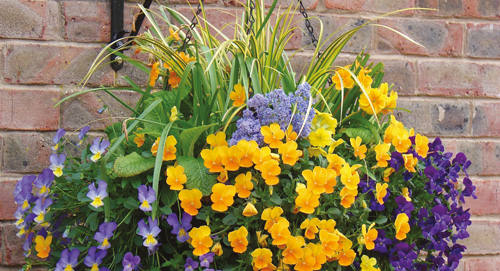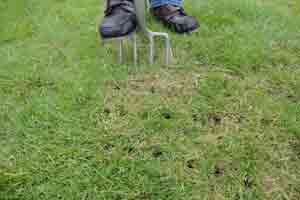October Garden Diary
Welcome to the October edition of our Garden Diary, written for us by Geoff Hodge, of The ScottsMiracle-Gro Company. Keep up-to-date with what needs doing in your garden with our month by month column.
October’s weather is usually very unpredictable. We could experience the first severe frost, or it may remain mild – we may even be blessed with an Indian Summer. Strong and cold winds can be expected in some regions and these can cause havoc to plants, drying them out, damaging the stems of climbers that aren’t firmly anchored to their supports – especially clematis – and knocking around plants in containers and hanging baskets. So, it may be time to batten down the hatches!
FLOWER BEDS & BORDERS
If you haven’t already done it, crack on with lifting fuchsias, marguerites, New Guinea busy Lizzies, osteospermums, pelargoniums (bedding geraniums) and all the other half-hardy bedding perennials for overwintering frost free. First tidy them up by removing all dead or diseased growth, and cut them back by around half if necessary to keep them compact. Then pot them up in pots just big enough to accommodate their roots, using Miracle-Gro All Purpose Enriched Compost, Miracle-Gro Potting Mix Root Boosting Compost or similar Miracle-Gro potting compost. Then move them into a cool greenhouse, conservatory or similar well-lit place and overwinter frost free. You’ll have lots of plants for next year and save yourself a fortune buying new ones.
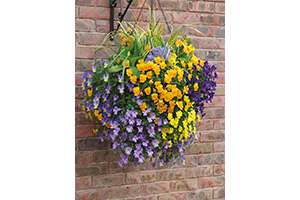 It’s also time to lift tender summer-flowering bulbs, such as gladioli and tigridia, so you can keep them in a cool shed or similar until it’s time to plant them out again next year. Wait for the leaves and stems to turn yellow and die down naturally. Carefully dig them up with a hand fork, remove any soil and cut down the stems close to the bulb or corm. Dry in warm sunshine for a few days before storing in mesh bags (or old nylon stockings) in frost-free conditions.
It’s also time to lift tender summer-flowering bulbs, such as gladioli and tigridia, so you can keep them in a cool shed or similar until it’s time to plant them out again next year. Wait for the leaves and stems to turn yellow and die down naturally. Carefully dig them up with a hand fork, remove any soil and cut down the stems close to the bulb or corm. Dry in warm sunshine for a few days before storing in mesh bags (or old nylon stockings) in frost-free conditions.
If you can’t or don’t want to lift them, you can protect them outside by covering the soil with a 10-15cm (4-6in) thick mulch of Miracle-Gro Moisture Control Decorative Pine Bark or Levington Water Saving Decorative Bark. This can be a bit hit and miss if we have a severe winter.
Tuberous begonias will definitely need lifting before the first frosts. Stop watering the plants when the leaves and stems begin to turn yellow and die back. Then carefully remove all the leaves and stems and soil or compost from the tubers. Store the tubers in barely moist compost or sand in a frost-free shed, ideally at 7C (45F). Lightly water the compost/sand occasionally if it gets too dry to prevent them shrivelling up.
Tidy up beds and borders by clearing away all dead and dying leaves and cut back the old and dead flower stems of herbaceous perennials. Any ornamental seed heads can be left in place to give some interest and structure to the garden over winter. Some are also useful food sources for birds and beneficial insects, such as ladybirds, may overwinter in them. All these materials can be used in the compost bin, but add Miracle-Gro Compost Maker to speed up their rotting.
Topical tip
If you didn’t plant all your spring-flowering bulbs last month – don’t panic! October is still an excellent month to plant them – but get it done by the end of the month. It is sometimes recommended to leave tulips until November, but this advice is now seen as unnecessary.
PATIO GARDENING
If your patio is starting to look a little drab after a colourful summer, then plant up containers with winter-interest plants to give you some cheery winter colour. There are lots of great shrubs and perennials to choose from, which will then provide interest, colour and structure throughout the rest of the year. You can choose from evergreens, winter-flowering shrubs, plants with berries and those with colourful stems.
To make the most of your containers and to ensure maximum colour, you can underplant with evergreen winter-flowering heathers, ivy and ajuga, which will also trail over the sides. Autumn, winter and spring bedding plants will also add extra colour and interest for many months. As will winter- and spring-flowering bulbs.
As shrubs and perennials are long-term plants, it is far better to plant them in loam-based Levington John Innes No 3 compost or a multipurpose compost with added John Innes, such as Levington Multi Purpose Compost with added John Innes. Composts containing loam are heavier than multi-purpose composts, so the containers are less likely to blow over in strong winds, often an important consideration with large shrubs.
Having spent the summer worrying about the compost in containers drying out and plants suffering from drought conditions as a result, now the opposite is true! Raise all patio containers on to bricks or purpose-made pot feet to avoid them sitting in water during autumn and winter. If you don’t, the water at the base of the pot will keep the compost overly wet and even waterlogged, which will lead to root rotting, and can make terracotta pots more prone to cracking.
Topical tip
Give containers a good going over with a scrubbing brush and water to remove any dirt, grime and build-up of unsightly algae.
If you didn’t manage to get around to all the vital autumn lawn care jobs in September – or you didn’t have time to finish them – there’s no need to worry! They can all be carried out this month too.
The jobs you’ll need to get on with, in order, are:
• Clear away fallen leaves
• Kill moss
• Rake & scarify
• Aerate
• Top dress
• Feed with an autumn lawn food
For full details on autumn lawn care and the jobs you need to do, visit LoveTheGarden.com – www.lovethegarden.com/lawncare/autumn-lawn-care
Topical tip
Although worms are good for the garden, they can be a real nuisance in the lawn, producing surface casts. Ignoring the casts and squashing them flat with your mower smothers the grass and provides a seed bed for weeds. Brush them away with a stiff broom whenever you see them.
GROW YOUR OWN
Vegetables
Even at this time of year, there are some crops that you can sow – particularly in mild regions. One of the best, for an early crop next year, is overwintering broad beans, such as ‘Aquadulce Claudia’. Covering the soil and developing young plants with fleece or cloches will provide insulation in colder areas, as well as protection from pigeons.
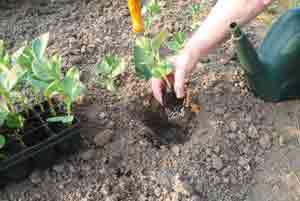 Carrots and even peas can be sown in mild areas in cold frames or growing frames. Radishes, mustard, cress, and winter lettuces can be sown in Miracle-Gro Gro Your Own Vegetable & Fruit Giant Planters in a greenhouse or in pots of Miracle-Gro Gro Your Own Vegetable & Fruit Enriched Compost kept on a light windowsill or in a conservatory.
Carrots and even peas can be sown in mild areas in cold frames or growing frames. Radishes, mustard, cress, and winter lettuces can be sown in Miracle-Gro Gro Your Own Vegetable & Fruit Giant Planters in a greenhouse or in pots of Miracle-Gro Gro Your Own Vegetable & Fruit Enriched Compost kept on a light windowsill or in a conservatory.
You can also plant autumn or Japanese onion sets for a crop in early to mid-summer next year. And you can also plant garlic, but make sure it is a variety suitable for autumn planting.
Most root vegetables can be left in the ground and gathered as you need them. In case a really cold spell prevents harvesting or even damages them, they can be lifted and stored in a cool, frost-free shed; only store healthy roots. Carrots left in the ground benefit from an insulating covering of straw or similar material under plastic sheeting. Parsnips produce sweeter roots if exposed to mild frosts. In cold districts, beetroots, carrots, celeriac and turnip are best lifted and stored for use over the winter.
Harvest pumpkins and squashes when they are ripe. Leave them in the sun, or in a greenhouse, for a few hours to allow the skins to harden and dry off, before storing them in a cool, dry, dark place.
Digging over the soil, especially bare areas in the veg patch, will expose many pest larvae and eggs to birds and frosts, reducing future problems. It will also deal with annual weeds and give you the opportunity to clear away perennial weeds.
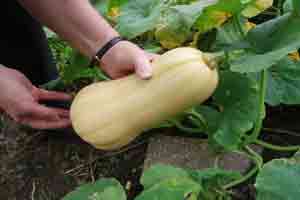 On poor soils, such as heavy clay or light, sandy soils, dig in lots of organic matter, such as Levington Organic Blend Soil Conditioner or Levington Organic Blend Farmyard Manure, to improve the soil structure. But don’t leave bare soil uncovered for too long, as it runs the risk of washing away valuable nutrients. Black polythene sheeting will protect the soil in the absence of any planting or soil-covering mulch.
On poor soils, such as heavy clay or light, sandy soils, dig in lots of organic matter, such as Levington Organic Blend Soil Conditioner or Levington Organic Blend Farmyard Manure, to improve the soil structure. But don’t leave bare soil uncovered for too long, as it runs the risk of washing away valuable nutrients. Black polythene sheeting will protect the soil in the absence of any planting or soil-covering mulch.
Topical tip
Gather together all your bamboo canes, clear away any plant debris and soil from them and store them somewhere dry until you need them again next spring.
Fruit
In cold regions, you may need to provide winter protection for wall-trained and container-grown figs to help the young figs overwinter to produce next year’s crop. You can cover wall-trained plants with plastic netting and fill between the plant and the netting with straw, bracken or other open insulating material. Or you can simply cover the plants with horticultural fleece – this will provide several degrees of frost protection. Coverings should remain in place until all danger of frost has past.
Lift and divide old, unproductive crowns of rhubarb and replant in well-prepared soil with plenty of added Levington Organic Blend Soil Conditioner or Levington Organic Blend Farmyard Manure, and add Miracle-Gro Bone Meal Natural Root Builder to help improve root growth and establishment.
Towards the end of October, put sticky grease bands on fruit trees to protect them from female winter moths. Tree stakes will also need grease-banding if they provide a route up into the branches for the moths.
Remove and destroy any apples, pears and plums affected with brown rot to prevent the disease from spreading. If the mummified fruit is left in the tree over winter it will affect next year’s growth and fruit.
And rake up and destroy any fallen apple, pear, plum and peach leaves infected with diseases, rather than leaving them on the ground. Garden hygiene is crucial in the control of these common problems.
Topical tip
Move tender citrus trees into a frost-free greenhouse or conservatory for the winter and reduce watering to keep the compost almost dry.
TREES, SHRUBS, ROSES & CLIMBERS
If bush roses have finished flowering, prune back their stems by up to half, as reducing their height now will prevent wind rock. These plants are generally shallow-rooted and can become loose in the soil if buffeted by strong winds, causing damage to the roots. Pruning now will also help remove disease spores and so reduce problems with blackspot, rust and mildew next year.
Layering is a good way to propagate many climbers and lax-stemmed shrubs. The layers should root by next spring. Choose a flexible shoot that can be bent down to soil level. Make a nick in the underside of the stem with a sharp knife at a node (where the leaves join the stem) where the stem touches the ground. Then dust the nick with hormone rooting powder and peg down the stem with a piece of bent wire or, better still, a small stone. Insert a small cane by the side of the stem and tie the stem to it to ensure it grows upright. Rather than pegging into the ground, you may get much better results, especially if your soil is poor, by rooting into small pots of Levington John Innes No 1 Compost.
Topical tip
Check tree ties and stakes are secure, especially on newly planted trees, before strong winds cause damage.
GENERAL GARDENING JOBS
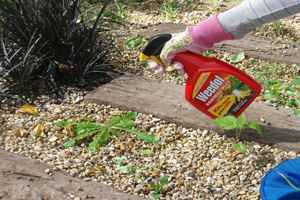 Cleanliness is vital in the garden, especially when it comes to clearing away fallen tree and shrub leaves. They can cause several problems in the garden – including providing a shelter for overwintering pests and smothering small and delicate plants and areas of the lawn, causing them to turn yellow and die. So there’s no getting away with it – start clearing up now!
Cleanliness is vital in the garden, especially when it comes to clearing away fallen tree and shrub leaves. They can cause several problems in the garden – including providing a shelter for overwintering pests and smothering small and delicate plants and areas of the lawn, causing them to turn yellow and die. So there’s no getting away with it – start clearing up now!
As the colder weather causes perennial weeds to die back, this is an excellent time to give them a final application of weedkiller. Systemic weedkillers, such as Weedol Rootkill Plus and Roundup will be taken down to the roots, killing them and the whole plant.
Topical tip
Although things in the garden may be quietening down now, don’t lock the back door and give up on your garden! Anything you can do now when the weather is conducive will get the garden ready for winter – and the spring ahead. It will also help take away some of the strain in spring, when there can be so much to do.
HOUSEPLANTS
As the central heating comes on, temperatures indoors rise – but humidity levels drop. This can badly affect many houseplants – particularly their foliage leading to dry, brown edges to the leaves.
Improve the humidity around them by misting daily, standing the pots on trays of damp gravel or Hortag and grouping them together. Reduce the watering of houseplants as the days shorten and their growth slows down. And never leave water sitting in plant saucers as this can cause root rotting.
There’s no need to feed foliage houseplants now until spring. But flowering houseplants will give a better display for longer if fed weekly with Miracle-Gro Pour & Feed
Topical tip
Keep removing dead, dying and yellowing leaves and fading flowers to keep your houseplants looking good and reduce the risk of diseases, such as grey mould (botrytis).
© all photographs copyright of ScottsMiracle-Gro.
Use plant protection products & biocides safely.
Always read the label and product information before use.Roundup® formulations contain glyphosate.
Weedol® Rootkill Plus and Weedol® Gun!™ Rootkill Plus contain glyphosate and pyraflufen-ethyl.Products marked ® and ™, Miracle-Gro® and Levington® are trademarks of The Scotts Company LLC or its subsidiaries.
Roundup® is the registered trademark of Monsanto Technology LLC.

